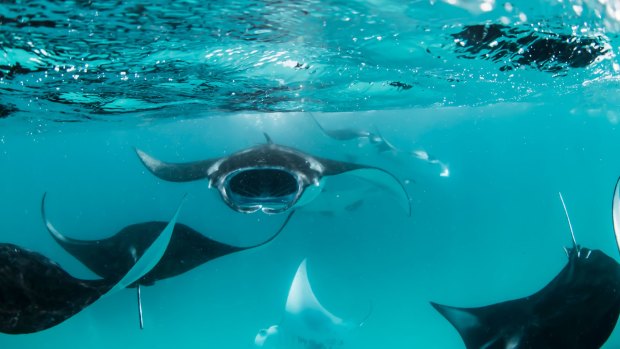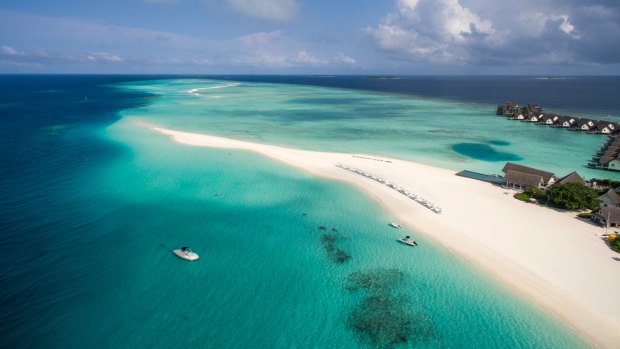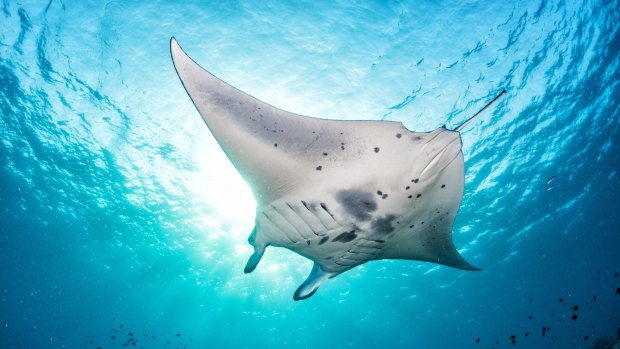This was published 5 years ago
Watching manta rays in the Maldives: a truly OMG moment
By Julie Miller

Maldives mantas.
I jump out of my private plunge pool and stretch out in the adjoining cabana, soaking up blue-horizon views and the indulgence of doing nothing. But I'm not totally relaxed: I glance at my phone, checking for messages. Nothing. I flick through the menu – no missed calls. I tap the screen – perhaps the battery needs charging?
Even in paradise, technology is a distraction. And these feelings of anticipation and disappointment are horribly familiar. But this is no Tinder date I'm fretting over – I'm waiting on the call of nature.
More specifically, my hot date is a large marine creature known to inhabit these parts, a manta ray. And the old-school Nokia phone in my possession, dubbed the manta phone, is an essential element of Four Seasons Landaa Giraavaru's Manta-on-Call program.

Four Seasons Landaa Giraavaru.
On arrival at this luxury resort, located on one of 75 coral cays that make up the UNESCO World Biosphere Reserve of Baa Atoll in the Maldives archipelago, I'm handed the phone in a waterproof pouch and told to monitor it religiously, taking it with me wherever I go between the hours of 9am and 5pm. Should mantas be spotted in nearby waters by the resort's team of researchers, I'll receive a text and within 15 minutes I'll be whisked off for a face-to-face encounter, snorkelling among the graceful creatures.
And so the waiting begins. I can't help but feel sceptical. After all, my record with marine animals is as chequered as my personal dating history – I just can't catch a break, with excursions to see whale sharks and humpbacks often resulting in long, fruitless searches and horrendous seasickness.
My chances here should be better than usual, however. Hanifaru Bay, located about 20 minutes by speedboat from Four Seasons Landaa Giraavaru, is the largest manta feeding station in the world, with up to 200 mantas at any one time gorging on plankton swept into the funnel-like reef system by monsoonal currents between June and November.

Hanifaru Bay is the largest manta feeding station in the world.Credit: Shutterstock.com
Monitoring the feeding frenzy and human interaction with the filter feeders are Marine Park rangers as well as researchers from the Manta Trust, based in the Marine Discovery Centre on Landaa Giraavaru. Only five boats, and a maximum of 80 swimmers are allowed in the bay during each 45-minute session, and there is no diving permitted, only snorkelling.
At the Marine Discovery Centre, an education, conservation and rescue centre for Maldivian sea creatures, I meet Manta Trust researcher Simon Hilbourne, who assures me that my manta phone could ring at any moment.
"Since we started our database in 2005, we've documented more than 4330 individual reef manta rays, with over 40,000 photo-ID sightings," he tells me. "Each ray can be identified by spots on its underbelly, unique markings like fingerprints. This is the most intensely-studied population of mantas in the world, and our guests are an important part of that. So make sure you bring your underwater camera!"
If and when the phone rings, that is. In the meantime, I wander through the Marine Discovery Centre, learning about the life and habitat of the animals that inhabit Maldivian waters, and admiring their breeding stock of little Nemo clown fish and elegant sea horses. I also hear about the resort's efforts to restore its surrounding reefs, which were extensively damaged during a 2016 bleaching event. Guests can sponsor their own coral frame planted with colonies more resistant to the effects of higher sea temperatures, and watch it spring to life via the internet.
Hilbourne also invites me to witness a special celebration – the release of an injured turtle back into the wild. There are about 20 turtles recuperating in pools at Landaa Giraavaru's Turtle Rehabilitation Centre. Most are victims of plastic pollution in the oceans, their flippers severed by insidious "ghost nets". Some, like male Olive Ridley turtle Chomper, have injuries that will see them confined for life, but Taissya is one of the lucky ones, with minor injuries that took just days to heal.
Surrounded by guests and staff, Taissya is carried to the water's edge and placed gently on the sand, where she tentatively feels her way towards the wide blue yonder. A cheer goes up as she accelerates through the turquoise shallows, headed for freedom – the 188th turtle successfully released since the centre was established in 2010.
Meanwhile, the Manta Phone is a permanent fixture around my neck, accompanying me on bike rides around the island, while I dine and even at the spa. Then, suddenly, at the end of my first complete day on the island, the phone beeps – it's a text from the mantas, apologising for their silence: "So sorry not to show up today – we were searching for plankton in another atoll but will be heading your way soon. Pease keep your manta phone to hand tomorrow and the recreation team will call you if they spot us!" Well, at least I know the phone works.
Of course, convenience is low on the priorities of wildlife and I'm literally caught napping when the phone beeps again mid-afternoon the following day. Mantas have been spotted, the text says, and we are to meet in 15 minutes at the Marine Discovery Centre for our date with destiny. There's a frantic scurry as I don my swimsuit, grab my camera and snorkelling gear and race to the wharf, where I join seven other guests on board Landaa Giraavaru's luxury speedboat.
Within half an hour, we arrive at Hanifaru Bay, but the scene that greets us is far from tranquil. We've been beaten to the punch by three other boats. The channel is awash with snorkels and fins as more than 40 bodies bob around in the swell. One tour leader, seemingly born with megaphone lungs, hollers for his group to stay close in a vain attempt to segregate the swimmers. As I jump overboard into the bath-warm water and attempt to follow Hilbourne's refreshingly quiet lead, I find myself swept into a jostling melange of fluoro-hued Europeans, buoyant dodgem cars with errant steering.
As I pull down my mask and submerge my slightly-irritated face, I discover there's good reason for the chaos. Directly beneath us are five or so giant rays, barrel-rolling and tumbling in an epic ballet, swooping with blatant disregard for the "three metre" rule imposed on their human admirers. Indeed, what I had first assumed was a deviant Russian flipper was in fact an enormous manta wing, gently shoving me aside in its wide-mouthed feeding frenzy.
Discovering that it's possible to swear and laugh at the same time into a snorkel, I hurriedly switch on my underwater camera, blindly pointing any which-way in an attempt to capture the massive beasts. In the distance I focus on a black-and-white kite soaring silently in my direction, huge mouth agape, only to realise there's one directly beneath me, eyeballing me curiously as it reveals its spotted underbelly before plummeting into the depths, barbless tail plunging like a knife.
Thankfully, time is up for the other swimmers; and as they make their raucous departure (why, oh why must people yell in the presence of such silent majesty?) our group suddenly has the performance to ourselves. Without the bodies restricting my vision, I realise there now are at least 20 mantas in the vicinity, a veritable conga line soaring to the surface, then diving in playful unison. It truly is an "oh, my god" moment, one no superlatives can describe. Awe-inspiring, magnificent, gobsmacking – nothing comes close.
Our 45-minute session is over before I know it. Never has time in open water passed so quickly, even for this less-than-confident swimmer. And as we speed back to the resort, seconds ahead of a brewing storm, the grins plastered on our collective faces speak volumes.
Later, I send my best photographs to Hilbourne to add to his research data. He comes back with three positive IDs based on the unique markings on the mantas' white underbellies.
One, a female called Buzzbee, is well-known to the researchers, a habitual visitor to Hanifaru Bay since the first sighting in 2010; another named Carmen was first sighted in 2014 and has since been seen 44 times. The third manta, however, is a relative newcomer who has only been seen twice, and is yet to be named.
My photograph of the creature, which clearly reveals her unique stripes and spots, is a cause for excitement for Hilbourne and his research team. So much so, he names her in my honour. So, thanks Joolz – that was some date!
FLY
Singapore Airlines flies to Male via Singapore. From Male, it's a speedboat ride to Four Seasons Kuda Huraa, with Landaa Giraavaru a further 35-minute seaplane flight. See singaporeair.com
STAY
A room at Four Seasons Landaa Giraavaru starts from $US1350. The Manta-on-Call program operates May to October, $US120 a person. See fourseasons.com
Sign up for the Traveller Deals newsletter
Get exclusive travel deals delivered straight to your inbox. Sign up now.